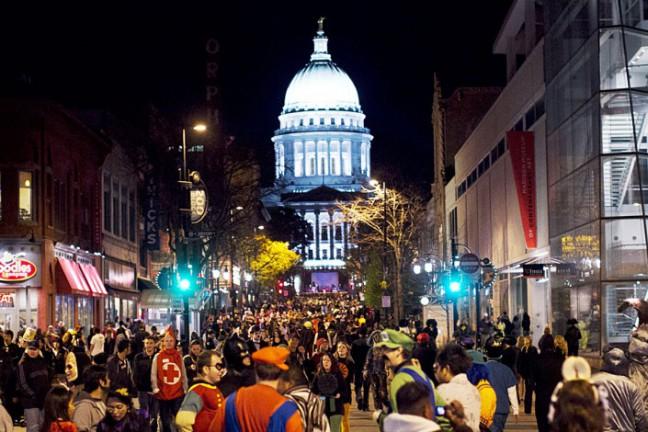Let’s all just agree on one thing: Pocahontas, Disney princess or not, is a no-no.
Now that that’s out of the way.
Halloween is spooky. Ghouls, zombies and, unfortunately, Harambe will be milling around State Street in a few short days in celebration of a centuries-old holiday permitting everyone to lose themselves in another body for the night.
But the spookiest piece of Halloween is not ghouls. For people of color, it is the annual, loud-and-proud reminder that their skin tone is a garb, their sacred traditions are packaged up on a dusty shelf at Ragstock and their clothes, so warmly cherished in their own home, are disposable shells for one evening, at the end of which they reek of vodka and sweat.
The year 2016 has callously tested the faith, stability and patience of minorities and allies with an unparalleled force. The Trump campaign has shattered whatever remaining illusion we clung to that this country at least has the humanity to stand up for basic human rights and respect for marginalized people. Police brutality has raged onward, sparking a conflict between law enforcement and Black Lives Matter which has left both groups angry, bruised and, in many cases, bloody. On the University of Wisconsin campus, hate and bias incidents have tripled and tensions are so high, you have to crane your neck to see the top.
Halloween will likely be another difficult night for ethnic minorities. Although cultural appropriation is by no means absent on any other day of the year, most people have no intention of making any sort of mockery on Oct. 30 or Nov. 1 by getting Chinese symbols tattooed on their back or wearing cornrows.
This is not the case on Oct. 31.
On Halloween night nobody cares. On Halloween night, you’re a Native American, gingerly applying war paint under your eyes and adjusting the feathers on a headdress from Etsy. On Halloween night, you’re a sexy Asian doll, hiking your skirt up just an inch higher and squinting your eyes for photos. On Halloween night, you’re Kanye West, slathered in brown paint with jeans sagging off your hips and the n-word on your tongue.
Maybe it’s hate which hides below the surface until late October, maybe it’s our discomfort with having these conversations which stands in the way of education and understanding, or maybe it’s the weather. I don’t know what it is about Halloween, but it seems to be a night which strips us of our common sense and any remaining respect for each other.
People of color have been manipulated, skinned, used as props and entertainment and trivialized for centuries by dominant and powerful groups in every corner of the world. They have faced expulsion, exclusion, abuse and death on the basis of the same traits and garments which hang seemingly-innocently from Party City racks. It is not until the approval of a white woman that henna becomes an exotic beauty rather than a strange, foreign scar. Before Angelina Jolie, the large lips genetically inherited by black men and women were, and continue to be, seen as comical, crude and ugly. Chinese symbols brand the ribcages of teenagers who roll their eyes at international students in the library, mocking their pronunciation, clothing and smell.
You get to peel off your bindi at the end of the night, but when South Asian men and women are stopped at the airport for random selection, booted off the plane for using the language of their homeland and forced to apologize for terrorist attacks they are as frightened by as you, they cannot step out of their skin to escape the burden when they’ve had enough.
Cultural appropriation on Halloween isn’t a big deal because we’re mad that you like our stuff. It’s a big deal because it reinforces the fatal, and thoroughly false, idea that being a person of color is a joke, a brief moment in time, rather than a lived experience — one which cannot be resized, resewn or resold. You get to enjoy our lives on a level of aesthetics, but are somehow absent when we are desperate for support in the wake of hate and prejudice?
The double-standard this appropriation exposes should horrify all of us. While white girls receive high-pitched compliments and awe at their box braids, black women suffer intense discrimination in the workplace over their natural hair. If they aren’t turned away from the interview on the basis of their afros or braids, and make it into the office, they are subsequently forced to consult employee handbooks which sternly remind them the skin they were born in is unprofessional.
This is the essence of racial hierarchy and oppression. When we wear what belongs to us, it is suspicious, rowdy or inappropriate. But when white college students pick it out for their costume, it wins contests.
If we desensitize ourselves to this sort of mockery and dominance, we forget that while costumes may be fleeting, the struggles of being a person of color last much, much longer. No “Nava-hoe” skirt can carry with it the pain in reservation communities following centuries of displacement and poverty, even if the light hair under your feathers and tan freckles lining your war paint swears to protect you from sex trafficking, addiction and isolation. And blackface isn’t fun anymore when an officer gets nervous about a boy in a hoodie who can’t erase the melanin from his skin with a make-up removing wipe.
As you rifle through thrift shop racks, remember to stay in your own lane. Put down the sombrero, you only took two semesters of Spanish. I’d rather you were Harambe.


